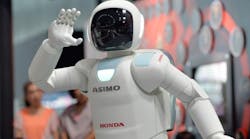Do American manufacturing workers need to fear having their jobs stolen by robots? Yes, but only if those robots are in use in China.
Conventional economic theory states that capital will substitute for labor when labor is expensive. Yet that is not what we are seeing around the world.
South Korea, whose average manufacturing wages are only about 70% of U.S. levels, has the highest density of robots in the world and has installed 9 times more than the U.S., as a percentage of its GDP. Other nations with lower manufacturing wages, like Spain and Thailand, also exceed the United States in robot purchases per dollar of GDP.
And despite manufacturing wages that are around 12% of U.S. levels, China surpassed the United States as the largest consumer of industrial robots in 2012.
Controlling for GDP, China bought over 50% more robots than the United States. This is one reason why Chinese manufacturing productivity, according to McKinsey Global Institute, has grown 8.7% annually between 2010 and 2013, compared to just 2.5% in the United States.
And this dichotomy in automation is only expected to grow. According to estimates made by the International Federation of Robots, (IFR) China could be buying over 2.5 times as many robots as the United States by 2017.
Unfortunately, as ITIF has pointed out, the increasingly dominant narrative in America has been one of robots being the enemies of workers, based on the misconception that robots destroy jobs.
Actual evidence suggests that the opposite is in fact true. The rate of industrial robot acquisition actually has a negative 0.34 correlation with the national unemployment rate in the 15 countries the IFR sampled.
Unsurprisingly, robot adoption has had a strong positive correlation (0.52) a nation’s balance of trade and a 0.61 correlation with current account balance. In other words, more robots means lower unemployment and better trade performance.
These correlations support the long-standing economic principle that advancing technology, whether in the industrial revolution or in today’s automated factory, has a positive impact on competitiveness and job growth.
The United States does not lose jobs because there is not enough work to be done but rather because U.S. industry is not competitive with foreign producers. More robots will help fix this.
Industrial robots depreciate relatively quickly, and are replaced on an average about every 12 years, meaning that the United States’ poor investment numbers cannot be easily attributed to pre-existing automation investment. In fact, the United States ranks just 6th in the world in terms of robot density, a measure of robots per employee, and is well behind Korea, Japan and Germany on this metric.
The assumption therefore that because the United States was historically a high wage nation (we are in fact no longer anywhere near the highest in terms of manufacturing labor costs) we must lead in automation and robot adoption, though pervasive, is false.
One reason why our competitors are investing more in robots is that the tax climate for investing in machines and equipment in many other nations is more favorable than in the United States. Not only is our effective corporate tax rate well above average for developed nations and the second highest in the OECD, U.S. tax incentives for infrastructure investment lag behind many other nations.
Countries like the United Kingdom, France and Singapore allow investments in capital equipment investment to be written off as expenses. Canada, Japan, Malaysia, and the United Kingdom implement accelerated depreciation schedules to make investing in machinery, like robots, more appealing for manufacturers. Other incentives designed to increase manufacturing investment also give competitor nations a considerable advantage. Making it costly for manufacturers in America to invest in and adopt the newest technologies will only exacerbate U.S. competitive struggles in advanced industries.
In short, our competitors are embracing robots and automation. We need to as well.
Adams Nager is a research assistant with the Information Technology and Innovation Foundation.




